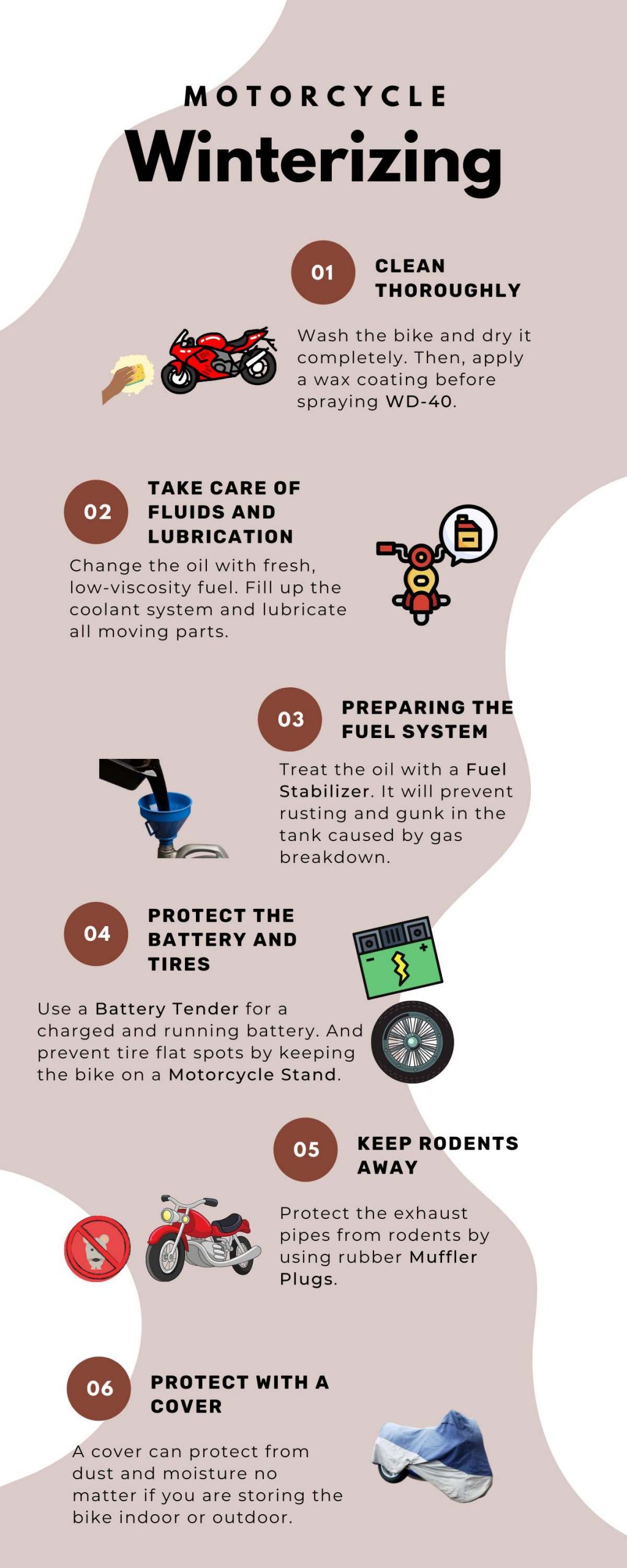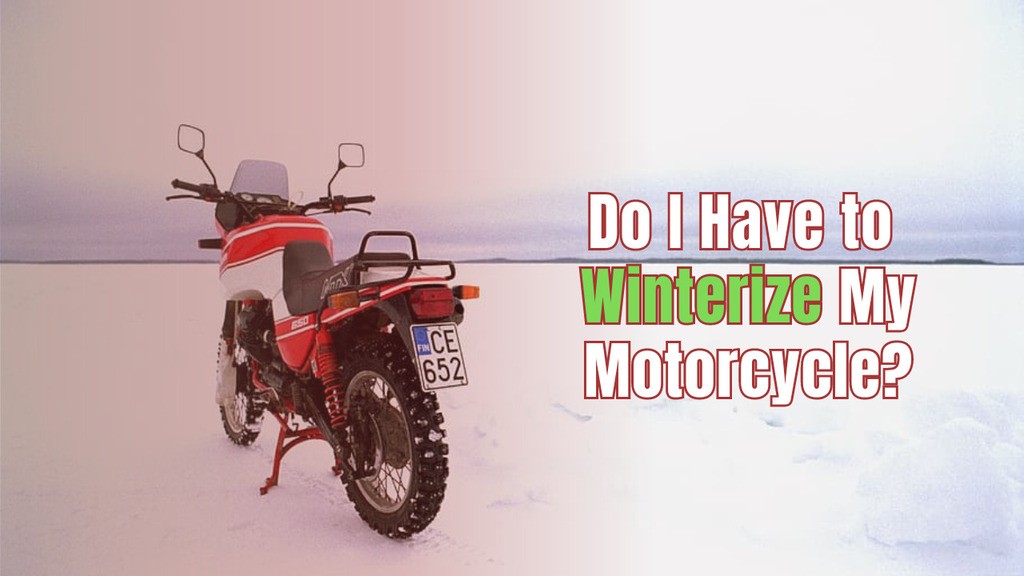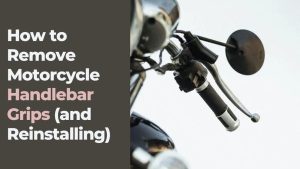Before the cold weather approaches, you need to take your motorcycle off the road to avoid freezing temperatures. Preparing the bike for winter storage is called winterizing, which can be a lot of work. Do I have to winterize my motorcycle? It’s a legit question that many bikers might have asked themselves.
If you live in a cold climate, it’s essential to winterize your motorcycle. Otherwise, you’ll end up with a bike with lots of hiccups.
The quick answer is, yes, it needs to be winterized. Let’s find out what winterizing is, what happens if you don’t do it, and how to winterize a motorcycle.
What Is Winterizing a Motorcycle?
Winterizing is the process of preparing a motorbike for storage during the winter months. It’s a part of maintenance work that makes sure the bike runs after prolonged storage. This protects against corrosion on terminals or sludge buildup inside cylinders.
You might be thinking about when to winterize motorcycle for the best result. Well, you can take the preparation throughout the autumn. Find suitable storage, collect necessary equipment, and do the bike’s servicing (if required). Then, finish winterizing tasks when the winter sets in or the weather gets too gloomy for riding the bike.
Do I Have to Winterize My Motorcycle?
Yes, you do. An un-winterized engine could have trouble starting next year because of corrosion on terminals or sludge buildup inside cylinders.
Not taking the necessary precautions can lead to expensive repairs down the road. Let’s discuss the troubles you may have to deal with for not winterizing the bike.
Deposits in fuel and cooling systems
Gasoline breaks down when not in use, resulting in deposits in the fuel system. This problem gets even worse if there is ethanol-blend gas in the tank. Sludge and gunk on the tank’s bottom can clog up the fuel lines, filters, and carburetors.
This may lead to poor engine performance and carburetor malfunction in the worst-case scenario.
Also, the radiator coolant starts to evaporate when a motorcycle isn’t used for an extended period. This can leave behind deposits that can clog up the cooling system and cause the engine to overheat.
Corrosion in metal parts
Unwashed and unwaxed metal parts will be susceptible to rust and corrosion during extended storage. Rust can cause irreversible damage to your bike’s electrical system and make it difficult to start in the spring. All exposed metal parts will collect dirt and rust, causing untimely wear and tear.
Serious tire damage
The tires will eventually lose pressure and crack if a motorcycle isn’t moved around. This is because the rubber in the tires dries out and weakens when it’s not used.
Flat tires are also common if a bike sits for a long time. This can cause the tires to wear unevenly and lead to premature failure.
Battery issues
One of the most common problems with motorcycles that sit idle for long periods is a dead or frozen battery. This can be caused by corrosion on the terminals, old age, parasitic drain, or simply not often used. If your battery dies, you will need to replace it, which can be expensive.
So, what can you do to prevent all of these things from happening? The best way is to winterize your motorcycle. Jump to the following section to learn the steps for proper winterization.
How to Winterize a Motorcycle in 6 Steps
If you want to make sure your bike survives the cold weather, you need to take some precautions. It can be tricky to keep a motorcycle in good condition during the winter months, but with our help, you’ll be able to do it like a pro!
Motorcycle Winterizing Steps Infographic

Do check the steps to get the best product suggestions for a foolproof winterization. By following these steps, you can make sure your bike stays in good condition all winter long.
Give the bike a thorough cleaning
Before you do anything else, give your bike an extensive cleaning job.

WD-40 Original Formula, Multi-Use Product with Smart Straw Sprays 2 Ways
FEATURES WE LIKED
- Drives out moisture
- Acts as a corrosion inhibitor
- Frees sticky mechanisms
Make sure to get the dust and grime off of it, and pay special attention to those surface parts that are susceptible to rusting.
Otherwise, dirt and water spots will become permanent and ruin the paint.
Don’t forget about applying a coat of wax to better protect the surface paint finish. Then, use a moisture-wicking spray like WD-40 on the exposed metal parts to prevent corrosion.
Take care of fluids and lubrication
Old oil can break down under colder temperatures, leading to engine problems. Fresh, low-viscosity oil like 5W30 has a lower chance of breaking down.

Amazon Basics High Mileage Motor Oil – Full Synthetic – 5W-30
FEATURES WE LIKED
- Prevents build up
- Reduces friction for less engine wear
- High resistance to viscosity and thermal breakdown
Also, oil-coating the engine parts is a good idea if the storage time is over 4 months. To do that:
- Put a tablespoon of fuel into the spark plug holes (remove the plugs).
- Put the motorcycle in gear and run the engine a couple of times.
- Change the spark plugs when the oil coating is done.
Does the weather in your area drop below freezing point? Then, don’t forget to fill up the coolant system with fresh antifreeze.
Lubricate all moving parts
As the bike will sit idle for a couple of months, lubricate all moving parts. Check the chain drive, fork surfaces, cables, and swiveling parts and apply a high-quality lubricant.
This will make it easier to get them moving again when spring arrives.
Prepare the fuel system
Will the bike sit out for an extended period, like over 2 months? Then, you should definitely prepare the fuel system. Fill up the gas tank all the way and add a fuel stabilizer to keep the gasoline from spoiling.
A stabilizer will stabilize the fuel, protect the engine from corrosion, and improve the bike’s overall performance.
Protect the battery and tires
Disconnecting the battery is critical for proper winterization. If you don’t, the battery will discharge and could end up being damaged.

Battery Tender Plus 12V Battery Charger and Maintainer
FEATURES WE LIKED
- Provides a full charge to your powersports vehicle’s battery
- Compatible with all 12V batteries
- Solid state two-color LED indicator
But keep it hooked up if you have a battery tender. It will monitor the battery’s power and recharge it when necessary.
Keep the tires off the ground by using a motorcycle stand for proper care. If it’s not available, at least put something like a rug or plywood under the tires. This will prevent tire cracking and flat spots.
Keep rodents away
Storing the bike for a long time will make it a suitable place for the nesting of rodents.
They will live in the exhaust pipes and tear down air filters and other internal parts.

FMF Racing 11299 Wash Plug Black, 4-Stroke
FEATURES WE LIKED
- 4-Stroke wash plug
- Diameter is 0.95″ – 2.0″
To prevent this from happening, plug up the pipes foam insulation or steel wool. The best measure would be to use muffler plugs.
This will keep the pests out and protect your bike from damage.
Protect with a cover
The last step of winterizing the motorcycle is to cover it up. There are plenty of good-quality motorcycle covers on the market, and it’s worth investing in one. This will keep the bike from getting wet (if stored outside) and keep moisture away.
By following these steps, you can make sure that the bike you’ll be ready to hit the road again when spring arrives.
Winterizing the motorcycle before the arrival of winter gives it optimal protection. This will help keep your bike from rusting, allowing it to be ready for use when the cold months are over.
FAQs about Motorcycle Winterizing
What does winterizing a motorcycle involve?
Winterizing involves preparing your motorcycle for storage during cold weather months. This may involve changing oil, removing the battery, fogging cylinders, spraying lubricants on metal parts, and adding fuel stabilizer to prevent the fuel from going bad.
How cold can an unwinterized motorcycle handle?
Without proper preparation, motorcycles can handle short periods of temperatures down to around 20°F. Below this, fuel lines and other parts may freeze and break. Prolonged exposure to temperatures under 32°F without winterizing greatly increases the risk of damage.
When should I winterize my motorcycle?
You should ideally winterize your motorcycle just before the first cold weather hits, usually in late fall. If the temperature is forecast to dip below freezing for more than a few days, it’s best to winterize to prevent damage.
Do I have to drain the gas tank when winterizing?
Most experts recommend fully draining the gas tank to prevent condensation and varnishing of the fuel from occurring over the winter. However, if you add a fuel stabilizer, you may not need to drain the tank as long as you top it off with fresh, stabilized fuel before riding again.
Do I need to cover my motorcycle during winter?
It’s a good idea to cover your motorcycle during the winter months for protection from the elements. A motorcycle cover can shield your bike from rain, snow, dust and UV rays that can cause damage over time. Check that the cover is breathable to prevent mold and mildew buildup.
Should I spray WD-40 on my motorcycle chains during winter storage?
While WD-40 can help loosen rust, experts recommend against using it on motorcycle chains during winter storage. WD-40 is not a permanent lubricant and will wash away with the first ride or rainfall, leaving the chain unprotected. Instead, use a purpose-made chain lubricant before storage.
Can I still ride my motorcycle during the winter?
With proper gear, your motorcycle can be ridden year-round for short trips. However, extreme cold can reduce power and handling due to stiffened engine fluids and tires. Invest in winter riding gear like a heated jacket, gloves and grip warmers to stay comfortable.
How do I prepare my motorcycle for long-term storage?
For storage over 6 months or more, in addition to normal winterizing, jack your motorcycle off the ground to relieve spring tension on the suspension. Inflate tires to the upper limit, and consider adding fuel stabilizer every 3 months to the gas tank. Also use a battery tender or trickle charger to keep the battery charged.




